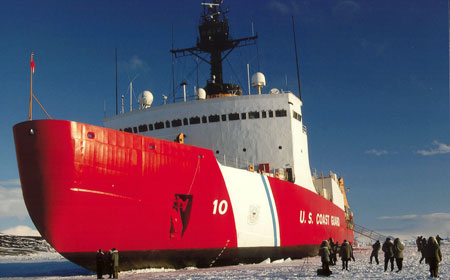
Builder: Lockheed Shipbuilding and Construction Company (Seattle, Washington)Commissioned: 1976Decommissioned:Length: 399 feetBeam: 83.5 feetDisplacement: 11,000 tonsSpeed: 18 knots (21mph), 3 knots (3.5mph) in 6-foot iceIce Capacity: 21 feet (ramming), 6 feet (continuous)Polar Class
Other Characteristics: Polar Star has four different methods of electronic
navigation to overcome the difficulties of high-latitude operations and a computerized
propulsion control system to manage nine generators and three turbines. The
shell plating and associated internal support structure are fabricated from steel
that has especially good low-temperature strength. The part of the hull designed
to break ice is 1.75 inches thick in the bow and stern sections. The hull shape
is designed to maximize icebreaking by efficiently combining the forces of the ship’s
forward motion, the downward pull of gravity on the bow, and the upward push of the
buoyancy of the stern. The curved bow and heavy weight allow the vessels to
force ice edges to break off downward.
History: During Antarctic deployments, Polar Star’s primary missions
include breaking a channel through the ice to resupply the McMurdo Research Station
in the Ross Sea. She is the only U.S. ship large enough to break the heavy sea
ice to access McMurdo. Polar Star also serves as a scientific platform
with five laboratories and accommodations for up to twenty scientists. “J”
shaped work cranes and work areas near the stern give scientists the capability to
do at-sea studies of geology, volcanology, oceanography, sea-ice physics, and other
disciplines.
